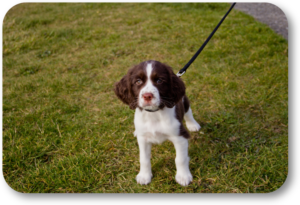I was at a new Home Dog Training client in Marietta last week helping him with his five-month-old English Springer Spaniel named Frank. Frank was a great puppy and very attentive to our commands. He was a little rambunctious and that required that we focused most of our lesson on proper behavior. Springers can be head strong so it takes a little more correction and direction to get their attention. After a short period of time Frank came around and was ready to learn my client’s “house rules”. He was very happy with the results and Frank appeared quite content to focus on my client for further direction and education.

One of the exercises that we worked on with Frank was walking outside. He was a little skittish when outside on a leash and my client needed help in getting things under control. Frank would always pull on the leash and try to run away from any distraction like big cars, joggers, other dogs, the garbage men, etc. Since he was a puppy, my client didn’t want to be too “heavy handed” with Frank, but also wanted to get things under control…
We have a terrific “walking tip” that has worked perfectly for many puppy owners over the years. When our client thinks that their puppy is going nuts or is scared of a distraction on the walk, that really isn’t the case. With older dogs, we often see this as a strong possibility because of inappropriate prior socialization or negative experiences. We need to remember that our little puppy is new to the world and every sight and sound around him is an amazing first-time experience. He has to make a “guess” if “that thing” is friend or foe.
We work with our clients to help them set up socialization experiences so that their little puppy feels safe while observing and/or hearing that new distraction. If the puppy is moving (walking at your side), he might not maintain that sense of safety.
As our client is walking their puppy, the first thing they must do as the leader and their puppy’s “Safety Provider” is to constantly scan ahead and behind for anything that might frighten or negatively distract him.
Let’s say that an Amazon truck turns the corner behind our client and is coming down the street. He should stop walking and put his puppy in a sit. If they are walking at the edge of the street, they should move about 10 to 15 feet back from the edge of the street and he should then have his puppy sit. Allow him to passively watch the truck pass and move out of sight.
If the puppy begins to bark or “leave his sit”, he should give the leash a slight tug, correct him, and have him sit again. If he thinks he is still too close to the side of the road, move farther away from the road and then put his puppy in a sit.
What we have had our client do here is to allow his puppy to observe this new distraction in the real world and in real time. He also allowed him to observe this “new thing” while feeling safe in his presence. This will be very important as Frank becomes accustomed to the surroundings around him and my client expands the privileges and expectations required of the walking exercise.
There are additional factors that need to be addressed when walking a new puppy. I went over them with my client and also would like to share them with you…
- It is always so easy to let your puppy take a quick sip from a puddle while you are walking. There are a lot of bad things that are living in the water that can easily make your puppy very sick. Always keep your puppy away from puddles. Take a water bottle and small bowl with you and stop for little “drink breaks” along the way.
- Walk at a good speed and only come to a stop when you think it is safe for your puppy to sniff and just be a puppy.
- Always pay attention to what is around you when you are walking. Always keep an eye on your puppy to make sure he is keeping his nose and mouth off the ground.
- Walk your puppy on a short leash. This takes away most of the chances of letting him get into trouble. It also makes is easier for you to keep him in control.
- Even though you thought you had kept him from getting into anything “bad” while on the walk, always watch your puppy when you are home. If you see he is having loose stool, becomes listless, or his eating habits change, call your vet and tell him what you are seeing. It is your responsibility to keep your puppy safe for his entire life. This all starts by just watching him.
Please call Robin or me at (770) 718-7704 if you need any dog training help. We are blessed to have been your local dog training experts for over sixteen years. We have trained over 5,000 great dogs and loving families and are ready to help you.

Follow Us!